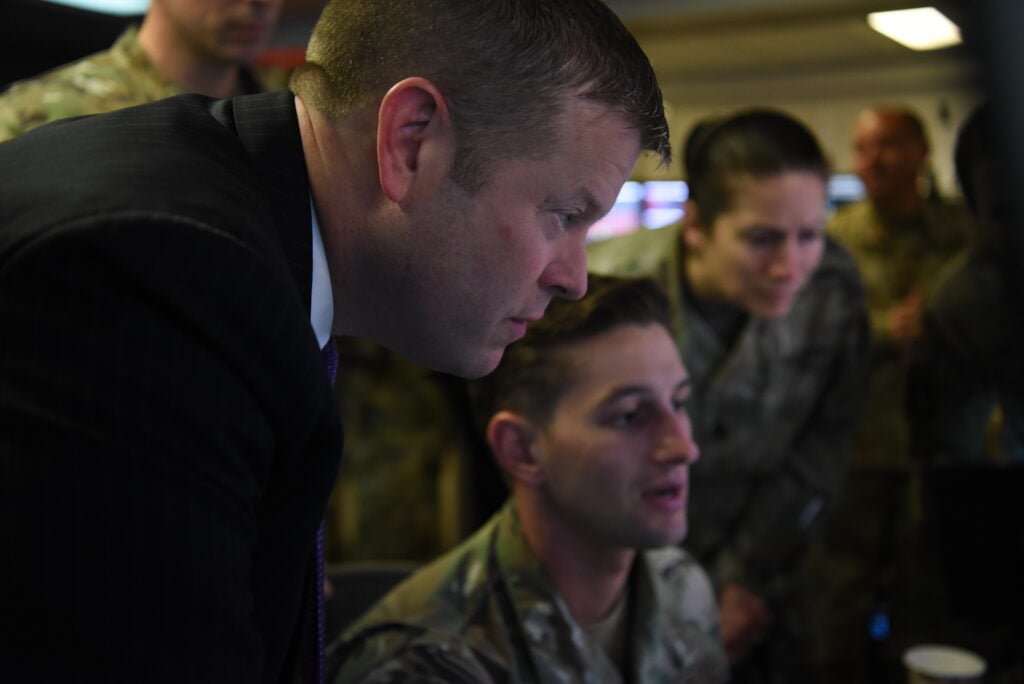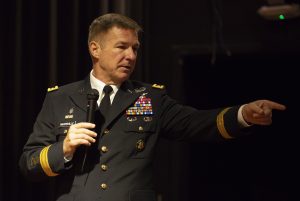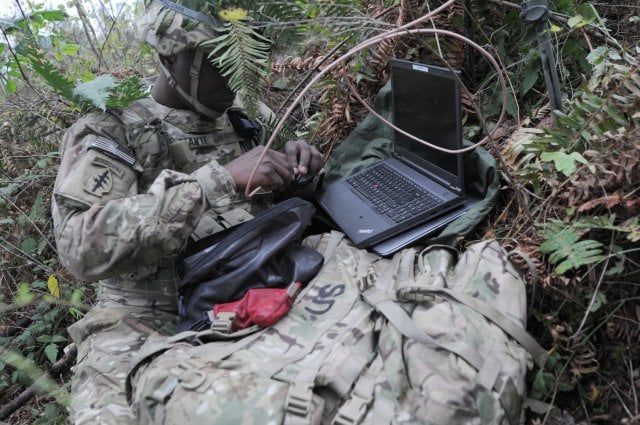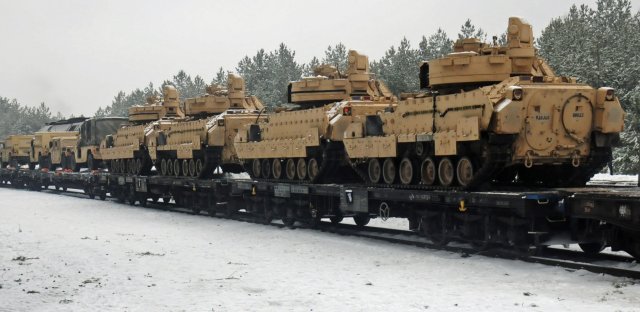Army Secretary Stresses Rapid Deployment, Information Warfare
Posted on

Ryan McCarthy visits soldiers in the United Arab Emirates.
UPDATED from Sec. McCarthy & Gen. McConville press conference AUSA 2019: “You can’t skip leg day,” Ryan McCarthy said this morning, less than a month after his confirmation as Army Secretary. “The last 18 years of conflict built muscle memory in counterinsurgency, [but] with this focus came atrophy in other areas. We are now re-engaging these muscle groups.”
“Going forward,” he went on, “we must put equal effort into improving our strategic readiness, which is the Army’s capability to rapidly mobilize and deploy forces anywhere in the world and sustain the Joint Force.”
That’s a subtly but significantly different emphasis from his predecessor, Mark Esper. So is McCarthy’s emphasis on information warfare to sway hearts and minds – and counter Taliban propaganda and Russian trolls.
Now, there is far more continuity than change. McCarthy served as Esper’s undersecretary before Esper moved up to the Defense Secretary job this summer. The two men formed a tight team with then-Chief of Staff Gen. Mark Milley – now Joint Chiefs Chairman – and then-Vice Chief Gen. James McConville – now Army Chief of Staff. The four worked literally side by side for hours on grueling “night court” reviews that cut or canceled 186 Army programs to fund the service’s Big Six modernization priorities, and the McCarthy and McConville remain ironclad in their commitment to that ambitious and often painful reform.
But no two individuals are the same, and every individual changes as the result of their experiences. McCarthy has led the Army as acting secretary as it ramps up wargames in Europe – leading to the massive Defense 20 exercise next year – and wrestles with the logistical, bureaucratic, and political challenges of embarking heavy equipment on ships, crossing the Atlantic, traversing strictly regulated European borders and transport infrastructure to get to the exercise zone, and connecting US command-and-control networks to often-incompatible European ones.
UPDATE When individual units train at their home base, or even one of the Army’s famed Combat Training Centers (CTCs), “it’s like individual reps,” McCarthy said at a subsequent press conference. But when “you’re deploying at brigade, division-sized element under wartime-like conditions, that’s where you’re really getting those pre-season games…. It takes a lot more effort, a lot more sophistication to have that global projection, and those are … muscles that we hand’t been training on for a long time.”

Gen. James McConville
“Over the last two or three years,” added Gen. McConville, the new Army Chief of Staff, “Gen, Milley, my predecessor did a fantastic job of taking our units and getting them ready for whatever mission… I term that tactical readiness — the brigades, the battalions, they can do their mission and they’re ready “
Now, “we’re looking at strategic readiness… making sure you get that unit to the place it needs to be,” McConville continued. “We want to make sure we can mobilize them, we can deploy them, we have the strategic lift to make that happen, the ports are there to receive them.” UPDATE ENDS
In recent months, McCarthy has also seen the Army increasingly focus on the so-called “competition phase” short of open war, when even great conventional powers like Russia rely on deniable proxies, propaganda, and online subversion. The head of Army Cyber Command has even announced a plan to reorganize and rename his organization into an Information Warfare Command.
UPDATE “We’re looking very hard at that proposal, it makes a lot of sense,” McCarthy said at his press conference. “if you see the way the other services are organized in particular, [it’s] similar to what he’s proposed.” That said, the plan must be reviewed with “rigor and due diligence” because it will change the command’s legal authorities. UPDATE ENDS
McCarthy’s clearly alive to these changing trends, because he took the opportunity of underlining them at his first speech as secretary to the massive Association of the US Army annual conference. Some key excerpts from his remarks:

A soldier from the Army’s offensive cyber brigade during an exercise at Fort Lewis, Washington.
On Information Warfare & Networks
Recently in Afghanistan, I watched MDO [Multi-Domain Operations] Information Operations in action. I watched our joint and partner forces counter and defeat Taliban’s online operation in an attempt to create chaos. The adversary’s claims of a tactical victory and towns under siege were quickly disproven through timely, truthful and targeted messaging.
The public could see for themselves local officials and partner leaders walking through the village square in real-time, via social media. A swift calm ensued in neighboring towns. The enemy, defeated in both reality and in their online narrative, fell silent again.
The right message, at the right time, to the right people, is the crux of MDO Information Operations and it is yielding results at the street level in Afghanistan like we have not seen in 18 years. If low-tech adversaries are able to execute offensive operations in the virtual domain, imagine what the Great Power Competitors are able to launch against us.
MDO allows commanders to rapidly build Joint formations, that are strategically positioned in order to fight and win across all domains- including space and cyberspace. Big data and network security become the next battlefield. If we do not have a system in place, access to the data becomes our no man’s land….. Seamless access to data in the cloud is the foundation for the entire Army modernization effort.

Bradleys of the 4th Infantry Division on a rail car in Poland.
On Multi-Domain Exercises & Strategic Deployment
A year ago at Joint Base Lewis-McChord, we activated the first Intelligence, Information, Cyber, Electronic Warfare, & Space Detachment, known as the I2CEWS, which serves as the core of the Multi-Domain Task Force…. The MDTF participated in Exercise Orient Shield in September with the Japanese Ground Self Defense Force operating in the East China Sea. With its headquarters in Japan, the Task Force elements were distributed south across the Senkaku Islands, serving as an important validation of capabilities as we build the multi-domain formations of the future.
This exercise, known as Pacific Pathways, has evolved to a 2.0 version – adopting a “hub & spoke” model by deploying task forces to single locations for a longer period of time and executing dynamic force employment of task force elements to “spoke” locations. For example, in May, we deployed a company from a hub location in the Philippines to Palau. This was the first time U.S. Army forces had been in Palau in 37 years. We aren’t just training in these areas and departing with lessons learned. We have a presence in the region, strengthened by partnerships and tested through tough, realistic and habitual exercises.
In Europe, this year III Corps and 1st Armored Division conducted a no-notice Emergency Deployment Readiness Exercise (EDRE), demonstrating the Army’s flexible global projection. Less than two weeks’ time passed from the moment a Soldier at Fort Bliss received the phone call, to the moment they placed their weapon on fire alongside our NATO counterparts at the Drawsko Pomorskie training area, Poland.
In FY20, the Army will conduct Defender 2020 to exercise, rehearse and validate how we would respond to a European crisis. This will be the largest exercise in 25 years. These forces will draw prepositioned stocks and establish communications on the continent. Nine C-17s will fill the skies with waves of paratroopers demonstrating Joint Forcible Entry, linking up with Special Operation Forces and conventional host nation ground forces….
To maintain readiness and enable our ambitious modernization agenda in a flat fiscal environment, the Army must ruthlessly prioritize our resources to achieve our modernization goals…..Army leadership will realign $10 Billion across POM 21 in order to finance our ambition and be in position to support National Objectives for years to come…. To Congress, I ask that you continue to support the Army divestment of legacy systems and push for a budget deal.
Subscribe to our newsletter
Promotions, new products and sales. Directly to your inbox.
